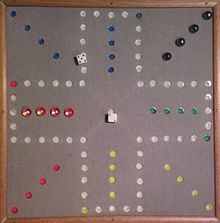
- Tabletop games
- Board games
- Tile-based games
- Turn-based games.html
- Abstract strategy games
- card games
- Connection games
- Mancala games
- Paper-and-pencil games
- Word games




Home made Aggravation board
|
|
| Players | 2-6 |
|---|---|
| Skill(s) required | Strategy, Probability |
Aggravation is a board game for up to four players and later versions for up to six players, whose object is to be the first player to have all four playing pieces (usually represented by marbles) reach the player's home section of the board. The game's name comes from the action of capturing an opponent's piece by landing on its space, which is known as "aggravating".
Aggravation is one of the many variations of the game Pachisi. It was first produced in 1960 by CO-5 Company. Later versions were made by Minneapolis-based Lakeside Industries, a division of Leisure Dynamic. Today, it is manufactured by Winning Moves, under license from Hasbro.
Its distinctive features are that the track that accommodates from four to six players, unlike other Pachisi-like games which only allow four; that it is normally drilled to accept colored glass marbles as playing pieces; and that it incorporates "shortcuts". There are no "safe" holes where a player's marbles cannot be captured (or "aggravated", in the game's parlance) other than the player's own base and home sections.
Older versions of the game usually feature an asterisk-shaped board, which is perfectly symmetrical and identical in shape and size from all angles. In addition, older versions allowed up to four players instead of six. However, modern versions of the game produced by Parker Brothers are made in an irregular pattern with a shape that varies for each player, though all players must travel an equal number of spaces in order to reach their respective home sections.
The game starts with each player's placing four marbles in his/her "base". After the order of play is determined through the rolling of the die, each player rolls a single die on each turn to determine the number of spaces to move. All marbles remain in the base until either a 1 or 6 is rolled, which entitles the player to move a marble from the base to his/her "start", the first step before entering the track. While this is considered a turn, and the move takes place in lieu of moving a marble that number of spaces, a six, if rolled, entitles a player to another turn whenever a legal move can be made.
The winner is the first player whose pieces all reach home by exact count. If playing partners when your partner has all their marbles in home then they can roll to help get your marbles home faster,
The hole in the center of the board is known as the "short cut". A player who is able to land a marble in this location by exact count has the option of taking a route even faster to home. The short cut, though, has the drawback in that it may only be exited by rolling a 1.
A player who lands a marble on a space occupied by an opponent's marble "aggravates" that player's piece and sends it back to that player's base. A player's piece may not be aggravated if it is on an inside corner as these are safe from aggravation. You must either land on the space before or after your opponent.
Players are prohibited during the game from landing on or passing their own marble. If this happens they can not move, if you rolled a 6 then you may roll again. If playing teams you can not land on or pass your partner.
The Unicorn Club has an annual season in which 30 games plus a series of two championship games (total 32 games) are played. Rather than using a board with marbles, a replica of the board is used on a field.
Each color represents a team of 5 players, one of whom is designated as the leader; they wear T-shirts in their respective colors. The four players take the place of marbles; the leader watches, rolls, and makes decisions.
Each team has five home games during a season. Fans of each team, who are usually family and friends of the players, come to its home games and root for the team.
Neutral officials are present at every game, making rulings in disputes.
In team play, the following new rules are added: